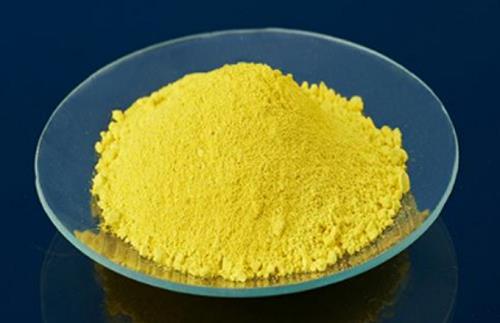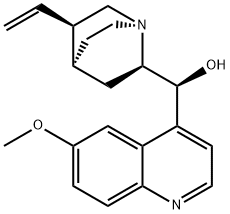Quinidine: A Reappraisal of Its Role in Cardiac Arrhythmia Treatment Despite Risks
Mar 28,2025
Quinidine is a medication used to treat certain heart rhythm disorders and malaria. It can cause serious side effects and increase the risk of death, especially in people with heart problems. Among the drugs listed in the ACC/AHA/ESC 2006 guidelines for the management of patients with AFib, quinidine is classified as "to be used with caution" and "safer methods with alternative agents" are recommended for pharmacological cardioversion.

Preparation of quinidine
600 ml anhydrous pyridine, 100 g crystallized quinidinone, and 300 ml. 25% solution of diisobutylaluminum hydride (DIBAH) in toluene were in a reaction vessel and the reaction was allowed to proceed until the reduction was completed as indicated by thin layer chromatography. The mixture was then heated under vacuum (25 mm Hg) to remove the pyridine. The reaction mixture was then treated with 750 ml. of a 50/50 mixture of water and ethanol, and after refluxing for 2 hours and cooling, 92.7 g of quinidine base were obtained, exhibiting a melting point of 174.5° C.[1]
Quinidine for Pharmacological Cardioversion of Atrial Fibrillation
Although quinidine has been used to terminate atrial fibrillation (AFib) for a long time, it has been recently classified to be used as a third‐line‐drug for cardioversion. However, these recommendations are based on a few small studies, and there are no data available of a larger modern patient population undergoing pharmacological cardioversion of AFib. Therefore, we evaluated the safety of quinidine for cardioversion of paroxysmal AFib in patients after cardiac surgery and coronary intervention. Our clinic is an inpatient cardiac rehabilitation center, conducting multidisciplinary and comprehensive therapy for secondary prevention after cardiac surgery or coronary intervention. In this setting, quinidine has been used for pharmacological cardioversion of AFib over a longer period without any serious side effects. Therefore, we hypothesized that cardioversion of paroxysmal AFib with quinidine may be safe and effective, and tested this assumption by retrospectively analyzing our database of 503 patients with modern interventional or surgical cardiac treatment undergoing cardioversion of paroxysmal AFib with quinidine.[2]
Traditionally, quinidine has been the class I antiarrhythmic agent of choice for pharmacological cardioversion of atrial fibrillation. Reports of an unacceptably high incidence of ADR such as gastrointestinal symptoms, dizziness, profound prolongation of the QT interval, torsade de pointes tachycardia, and even increased total mortality have displaced quinidine as a first‐line drug for pharmacological restoration of sinus rhythm in patients with atrial fibrillation. In the study of Naccarelli et al., randomly assigning 117 patients to quinidine therapy for cardioversion of paroxysmal AFib, inclusion criteria (LVEF ≥35%, maximum corrected QT interval < 500 ms, normal routine clinical laboratory results) and quinidine drug dosing (500 mg to 1500 mg per day) was very similar to our protocol. As in our evaluation, there was no life‐threatening proarrhythmic effect, no torsade de pointes tachycardia, and no death in the quinidine‐treated group. In addition, cardiac ADR responded to drug discontinuation, reduction in dose, or any other acute treatment and most of the general ADR did not require drug discontinuation as it was the case in our study.
Considering the small number of patients studied so far, the heterogeneity in study design, and inclusion criteria as well as the conflicting results of the prevailing older studies, literature available about quinidine is inconclusive. As described above, it might not only be the drug but also a wrong patient selection that caused the unfavorable position of quinidine as compared with other antiarrhythmic medication for pharmacological cardioversion of AFib. 1 This view is supported by current randomized controlled trials, showing that quinidine is even safe during long‐term treatment in carefully selected patients. Assuming, that quinidine is similar to other antiarrhythmic drugs with respect to efficacy and toxicity, its true potential for cardioversion should be evaluated in a suitable patient cohort according to the principles of evidence‐based medicine. Using the inclusion and exclusion criteria of this evaluation, quinidine seems safe enough to be tested in a large randomized controlled trial.
The modern era of antiarrhythmic therapy
Quinidine has a very long history as an antiarrhythmic medication. First described in 1848 by Van Heymingen the drug has been used in the treatment of almost all cardiac arrhythmias, particularly atrial fibrillation (AF), since the early twentieth century. Despite decreases in clinical prescription in the last two decades mainly due to the concern of side effects such as pro-arrhythmia, leading to increased mortality and to the availability of newer anti-arrhythmic drugs and catheter based ablation, quinidine remains one of the oldest cardiac drugs still available in the modern era of antiarrhythmic therapy.
The reabsorption of quinidine salts is done predominately in the basic environment of the gastrointestinal tract. After oral intake around 70% of the sulfate preparation is absorbed and the peak serum concentration of quinidine is reached after 2 h. The polygalacturonate and gluconate salts are slowly absorbed and less completely than sulfate salt. The rate of absorption is slowed when the drug is taken with food but the extent of absorption is not influenced. The first-pass metabolism in the liver influences its bioavailability. Quinidine has a large volume of distribution, around 2–3 L/kg in healthy young adults. It is increased in patients with cirrhosis up to 3–5 L/kg and reduced to 0.5 L/kg in patients with congestive heart failure. In the serum it is protein bound (80–88% in adults, 50–70% in children and pregnant women) mainly to albumin and alfa 1- acid glycoprotein. Its concentration is 4–10 times higher in the heart, liver and kidneys as it is in blood circulation. The effects of quinidine after oral administration of 400–600 quinidine sulfate start 1–3 h after intake and remain for 6–8 h.[3]
The drug is eliminated mainly through hepatic metabolism via the action of cytochrome P450IIIA4 and several different hydroxylated metabolites are produced. Some of them also with antiarrhythmic activity. Quinidine is hydroxylated through CYP3A4 to 2-Quinidinon and to 3-hydroxyquinidine (3HQ), as the 3HQ is the most important metabolite with serum levels that can exceed those of quinidine sulfate also at conventional dosage. Quinidine is an inhibitor of CYP2D2 isoform of Cytochrom P 450. The elimination half-life of quinidine is 5–8 h and can be prolonged in elderly and heart failure patients and reduced to 3–4 h in children. Quinidine renal excretion is increased with a urine pH < 6 and it’s reduced if the urine is alkalized therefore increasing its blood concentrations. Renal clearance involves both glomerular filtration and active tubular secretion with a pH-dependent tubular reabsorption. Gender differences in tolerability of quinidine are related to the prolonged baseline QT-interval in women, influenced by sex hormones and by sex-hormone-related differences in the density of potassium channels. In patients treated with quinidine, no differences regarding anti-arrhythmic efficacy are reported but women are more likely to discontinue the therapy because of QT prolongation and torsades.
As long as three decades ago, quinidine was still one of the most used antiarrhythmic drugs. It was slowly abandoned because of a combination of factors including safety concern and new, effective, therapeutic alternatives. On the other hand, quinidine has been demonstrated to be a live-saving drug able to control ventricular arrhythmias in patients with channellopathies, in particular the Brugada’s syndrome. Quinidine is no longer commercially available in many countries, being an acquired “orphan drug”. Its current role as antiarrhythmic drug should be known and quinidine should no longer be considered as part of the history of antiarrhythmic therapy.
References
[1]BOURRELLY JACQUES - US4174449, 1979, A
[2]Schwaab B, Katalinic A, Böge UM, Loh J, Blank P, Kölzow T, Poppe D, Bonnemeier H. Quinidine for pharmacological cardioversion of atrial fibrillation: a retrospective analysis in 501 consecutive patients. Ann Noninvasive Electrocardiol. 2009 Apr;14(2):128-36.
[3]Vitali Serdoz L, Rittger H, Furlanello F, Bastian D. Quinidine-A legacy within the modern era of antiarrhythmic therapy. Pharmacol Res. 2019 Jun;144:257-263.
Butafosfan, a compound of organic phosphorus, is used as a phosphorus source for animals and plays a vital role in hepatic carbohydrate metabolism.....
Mar 27,2025APITryptamines are a group of monoamine alkaloids, which can be synthesized by decarboxylation of the aminoacid tryptophan.....
Mar 28,2025APIQuinidine
56-54-2You may like
- The Duality of Sanguinarine: Anticancer Potential, Carcinogenic Controversy and Clinical Outlook
Apr 1, 2025
- Acid Red 18: Applications in Dyeing, Pollution Issues, and Treatment Approaches
Apr 1, 2025
- DL-methionine methylsulfonium chloride: Effects on Gastric Conditions and Adipocyte Differentiation
Apr 1, 2025






